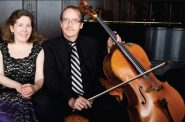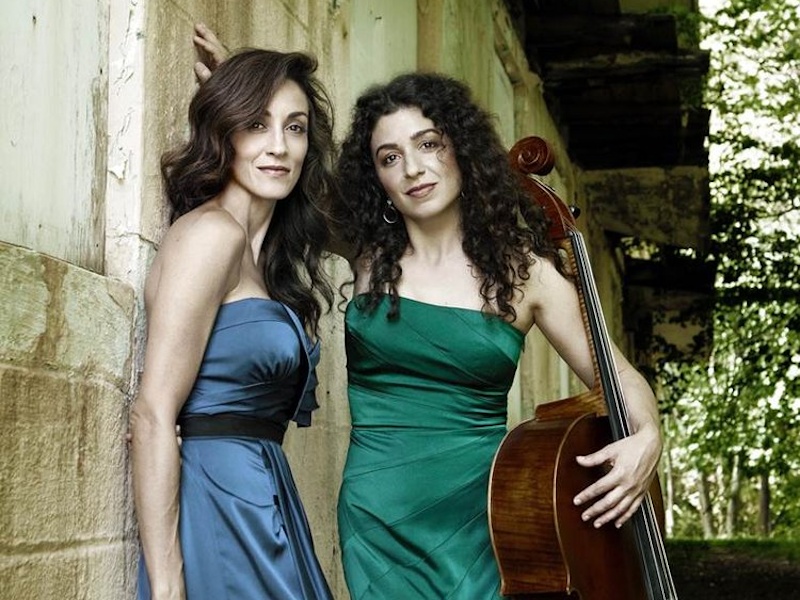Frankly Music Features the Acclaimed Aznavoorian Sisters
Performing works influenced by Armenian and Spanish folk traditions.
Frankly Music‘s upcoming concert on Monday evening, May 5, brings together violinist Frank Almond and the acclaimed Aznavoorian sisters—cellist Ani and pianist Marta—in an intimate chamber program celebrating the 200th anniversary of Czech composer Bedřich Smetana‘s birth.
“I’ve been wanting to have them both here for some time,” says Almond. “Marta has been back here several times, but her sister is out in California, and it’s hard to get her here. This was the perfect opportunity to showcase their incredible musicianship while also celebrating Smetana’s anniversary.” The program’s broader theme explores other cultural traditions in classical music, beginning with the Aznavoorians’ celebration of their Armenian heritage while including the diverse cultural traditions of Spain reflected by Manuel de Falla.
The Armenian-American Aznavoorian sisters bring impressive credentials to this performance. Marta Aznavoorian, described by the Boston Globe as “a pianist of exceptionally finished technique and purity of musical impulse,” made her professional debut at age 13 with the Chicago Symphony Orchestra under Sir Georg Solti. She is a founding member of the Grammy-nominated Lincoln Trio and studied with renowned teacher Menahem Pressler.
Cellist Ani Aznavoorian has performed with many leading orchestras worldwide, including the Chicago Symphony, Boston Pops, and Tokyo Philharmonic. The Strad magazine praises her “scorchingly committed performances that wring every last drop of emotion out of the music.” Currently Principal Cellist with Camerata Pacifica, she received both her Bachelor and Master degrees from Juilliard, where she studied with Aldo Parisot.
The first half of the program showcases the Aznavoorian sisters performing works reflecting diverse cultural traditions.
The duo will present Armenian Songs, selections from Armenian composer Vartabed Komitas, whose work preserves the unique modal characteristics and emotional depth of traditional Armenian music. Komitas collected over 3,000 pieces of Armenian folk music, though many were lost during the Armenian Genocide of 1915. His arrangements maintain the authentic character of traditional melodies while elevating them through sophisticated harmonization. The Aznavoorian Duo features Komitas’s collection of Armenian songs on Gems of Armenia, their first joint CD release.
Armenian music includes many characteristics of Middle Eastern music, featuring modal frameworks that offer an alternative approach to musical organization compared to the major-minor tonal system that dominated Western classical music. Modal music is built on scales with specific patterns of whole and half steps that create distinctive sonic characteristics. When arranged for Western Classical instruments, some of the character of Armenian music is tempered. Compare this Komitas song, The Crane, with voice and traditional instruments to the Aznavoorians’ version for cello and piano. The haunting beauty of the melody is not lost in either version.
Armenian themes are also represented by Alexander Arutunian‘s lyrical Impromptu for cello and piano, exemplifying the Armenian composer’s characteristic style that merges Eastern European melodic sensibilities with virtuosic demands.
De Falla’s Suite Populaire Espagnole, a work that brilliantly synthesizes Spanish regional traditions, is rooted in a more studied approach. Originally composed in 1914 as Siete canciones populares españolas, a vocal work with piano, the suite portrays the distinctive musical characteristics of different regions of Spain.
The songs span Spain’s diverse regions: Asturiana from northern Asturias, Jota from northeastern Aragon, and both the gentle Nana lullaby and passionate Polo from Andalusia. Canción explores the pain of betrayal in love – also a recurring Andalusian theme. Throughout the collection, the texts navigate love and courtship with moods ranging from playful flirtation to profound tragedy. The cultural traditions of these regions differ substantially. De Falla’s work contributed to the development of a pan-Spanish musical identity. De Falla and Paul Kochanski arranged six of the Siete canciones for violin as the Suite Populaire Espagnole. This arrangement has been further adapted by Maurice Maréchal for cello and piano.
The evening’s centerpiece, Smetana’s Piano Trio No. 1 in G minor, represents a contrast to the composer’s better-known nationalist works that would emerge later in his career. “This is not explicitly a nationalist piece. Not at all,” Almond emphasizes. “It’s much more deeply personal and emotional for him because of the death of his daughter.”
Written in 1855 following the devastating loss of his four-year-old daughter Bedřiška to scarlet fever, the trio reveals stronger influences from German Romanticism. “It’s a piano style that is very reminiscent of Liszt, who ended up being one of the very few people who championed the piece after its initial reception,” explains Almond.
The first movement contrasts anguished, desperate gestures with a tender lyrical melody (reportedly his daughter’s favorite), creating a dramatic interplay between grief and memory. Listen for the brief Chopin-esque piano solo midway through and the noble cello theme before the coda. In the second movement’s scherzo, two distinct trio sections provide emotional counterbalance to the surrounding agitation—first through a gentle, sighing melody and then through a solemn, portentous march. The finale’s galloping rhythm evokes desperate flight, reminiscent of Schubert‘s Erlkönig, interrupted by moments of lyrical reflection before encountering the inevitable funeral march, finally achieving transcendence with its conclusion.
This exceptional concert presents a rare opportunity to experience how diverse cultural influences have shaped classical music, from the personal grief expressed in Smetana’s German-influenced trio to the authentic folk traditions preserved in Armenian and Spanish works.
The Monday, May 5 concert at Schwan Concert Hall at the Wisconsin Lutheran College (8815 W. Wisconsin Ave.) begins at 7:00 p.m. Tickets may be purchased online or at the door.
If you think stories like this are important, become a member of Urban Milwaukee and help support real, independent journalism. Plus you get some cool added benefits.
Preview
-
James Kennerley Comes to Town
 Apr 26th, 2025 by Martha Brown
Apr 26th, 2025 by Martha Brown
-
Tales of the Renaissance Era
 Apr 21st, 2025 by Martha Brown
Apr 21st, 2025 by Martha Brown
-
Here’s Some Music That Stalin Banned
 Apr 14th, 2025 by Martha Brown
Apr 14th, 2025 by Martha Brown




















